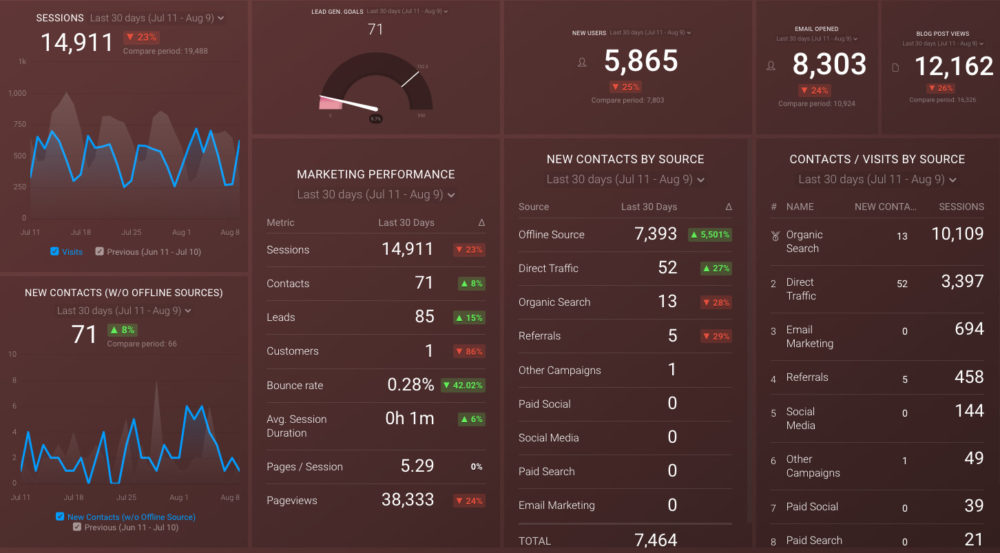Table of contents
A good marketing strategy report can make or break your business.
How?
Well, this is the report that will help senior management decide whether the strategy works in the first place. No wonder marketing is the most monitored and reported operation – as Databox’s state of business reporting revealed.
Your report should address company performance under the strategy and clearly show whether the strategy had been effective in achieving business goals.
Lastly, analysis of the strategy and how the company implemented it is key for future marketing strategic planning.
Sounds complicated? It doesn’t have to with our guide. Here is the framework that you can follow to draft a great marketing strategy report.
- What is a Marketing Strategy Report?
- Why Do You Need a Marketing Plan?
- What Should be Included in a Marketing Strategy Plan?
- How to Write a Marketing Strategy Report
- Free Marketing Plan and Strategy Templates
- Monitor Your Marketing Performance on One Screen
What is a Marketing Strategy Report?
Marketing strategies are the plans and frameworks you execute to achieve previously set business goals (for example, for SaaS, it could be converting your target audience into paid customers). A marketing strategy report should be a comprehensive document that includes the strategies and tactics that will be used to promote and market your company. This type of report provides an overview of your company’s marketing strategy and the competitive landscape in which it operates.
Related: Business Report: What is it & How to Write a Great One? (With Examples)
Why Do You Need a Marketing Plan?
Your company may be spending thousands of dollars on marketing, but if you don’t have an overall marketing plan in place, you may not be getting the best return on your investment. By following a proven marketing planning process and focusing on key performance indicators (KPIs), you can determine what is working and what needs improvement. You can then develop a strategy that covers all aspects of your company’s marketing activities.
Related: How to Write a Meaningful Marketing Plan: Starting with These 8 Tips
What Should be Included in a Marketing Strategy Plan?
Here are some key components that should be included in your marketing strategy plan:
- Business information. A section of your plan that gives the reader a brief overview of the most important aspects of your business. This includes information about your business’s headquarters, mission statement, contact information, and marketing team.
- Introduction/Goals, A section that lays out the basics of your marketing plan: what you’re hoping to achieve and how. The introduction should also include some background on your business — a brief overview of who you are and what you do.
- Competitive Analysis. Understanding your competitors’ tactics, as well as their target audience, will help you develop a winning marketing strategy.
- SWOT Analysis. The SWOT (strengths, weaknesses, opportunities, and threats) analysis provides a snapshot of the internal and external environment of your business.
- Target Market. This can be as simple as deciding whether you will be targeting men or women, people in their 20s or 40s, Hispanics, African Americans, Caucasians, and so on.
- Buying Cycle. The buying cycle is the process your customers go through when they purchase something from you. It’s not a rigid, set-in-stone process, but there are some common stages your buyers will go through no matter what they are buying.
- Unique Selling Proposition (USP). The USP is something that will convey to your customers what makes you stand out from the rest of the businesses in your niche. It has to show them how you can help them solve their problem and how they will benefit from choosing your business over others.
- Brand. The perception of your brand can make or break a business. For most companies, the term “brand” means more than simply slapping a logo on a product and calling it good.
- Website. The most important thing to remember is that your website must be optimized for search engines as well as for regular readers.
- Marketing Channels. List down all the marketing channels that you’ll use to reach out to prospective customers and explain how each channel fits into the big picture.
- SEO. With a good SEO plan, you’ll be able to effectively increase organic traffic to your website and start generating more leads for your business.
- Measurements and KPIs. Measurements and KPIs (Key Performance Indicators) are the foundation of how you’ll be evaluating your marketing plan.
- Marketing Strategy and Tactics. Tactics are the individual actions that make up the overall marketing strategy.
How to Write a Marketing Strategy Report
In order to write a marketing strategy report, you need to present facts, figures, and recommendations in a logical manner. The analysis of the strategy in relation to company objectives presents guidance for future strategic planning. That is the reason why the focus of your report should be on developing a clear understanding of how the subject strategy had an influence on favorable or unfavorable results.
The following 4 pillars should be the core of the marketing strategy report:
Objectives
No matter if a company sets out to formulate an overall marketing strategy or develop a specific marketing campaign, it has to be able to describe its business and marketing objectives. An objective is a concrete and measurable result, which the company wants to achieve with its strategy or specific campaign. For example, if a company wants to sell more of its product range in the next 5 years, then the objective of the overall strategy could be “to increase sales volume by 15%.”
Performance
The strategy performance section provides a good opportunity to evaluate the validity of the strategic choices made and whether they were appropriate for the set goals. This section of the report is not just a summary of facts. If a strategy was not successful, you will want to explain why. You might refer to your discussion of external or internal factors that affected the strategy, and how you can improve the strategy in the future.
Issues
This section addresses the specific issues that encompass the company’s marketing challenges. The issues may include something as large as addressing a new market or as small as reconciling two different sales regions’ approaches to pricing. Even if you have already considered these issues, writing them down in this section forces you to be more objective about them.
Solutions
The most common mistake companies make when preparing a marketing strategy report is not including solutions to problems. Your report is a chance to present your solutions. It’s not just an opportunity for you to say what happened and why it happened, but also for you to provide answers. If you’re proposing a new strategy, your report can include the information needed to implement it. To make these reports easier to build and present, use marketing reporting software (like Databox).
PRO TIP: How Well Are Your Marketing KPIs Performing?
Like most marketers and marketing managers, you want to know how your efforts are translating into results each month. How is your website performing? How well are you converting traffic into leads and customers? Which marketing channels are performing best? How does organic search compare to paid campaigns and to previous months? You might have to scramble to put all of this together in a single report, but now you can have it all at your fingertips in a single Databox dashboard.
Our Monthly Marketing Performance Dashboard includes data from Google Analytics 4 and HubSpot Marketing with key performance metrics like:
- Website sessions, new users, and new leads. Basic engagement data from your website. How much traffic? How many new visitors? How many lead conversions?
- Lead generation vs goal. Did you reach your goal for lead conversion for the month, quarter, or year? If not, by how much did you miss?
- Overall marketing performance. A summary list of the main KPIs for your website: sessions, contacts, leads, customers, bounce rate, avg. session duration, pages/session, and pageviews.
- Email response. Overall, how effective were your email campaigns, measured by email opens?
- Blog post traffic. How much traffic did your blog attract during a certain period?
- New contacts by source. Which sources drove the highest number of new contacts
- Visits and contacts by source. How did your sources compare by both sessions and new contacts in a certain period of time?
Now you can benefit from the experience of our Google Analytics and HubSpot Marketing experts, who have put together a plug-and-play Databox template that contains all the essential metrics for monitoring and analyzing your website traffic and its sources, lead generation, and more. It’s simple to implement and start using as a standalone dashboard or in marketing reports!
You can easily set it up in just a few clicks – no coding required.
To set up the dashboard, follow these 3 simple steps:
Step 1: Get the template
Step 2: Connect your HubSpot and Google Analytics 4 accounts with Databox.
Step 3: Watch your dashboard populate in seconds.
Free Marketing Plan and Strategy Templates
Marketing dashboards help visualize your marketing efforts and can help you track progress, identify areas for improvement, and help you come up with even more effective marketing tactics. This source includes 200+ ready-to-use marketing dashboard templates that you can use for free. All templates are fully customizable and work across multiple devices. Lastly, they are based on some of the most popular marketing and analytics tools like Google Analytcs, Google Seacrh Console, Ahrefs, Semrush, Google Ads, HubSpot Marketing, etc.
- Marketing Overview Dashboard
- Google Analytics (Website Measurement Plan) Dashboard
- Google Analytics (Content Marketing Overview) Dashboard
- Social Media (Social Media Overview) Dashboard
- Monthly Marketing Performance Dashboard
Marketing Overview Dashboard
A glance at this dashboard can tell you whether you’re getting enough traffic to your website and if you’re converting those visitors into leads. Download our Marketing Overview Dashboard to instantly visualize the following metrics:
- Monthly Visits
- Monthly Contacts Created
- Email Opens/Clicks
- Blog Post Views
- Landing Page Submissions

Google Analytics (Website Measurement Plan) Dashboard
This simple Google Analytics (Website Measurement Plan) Dashboard is designed to help you present the strategy behind your’s or your client’s website, marketing efforts, and/or campaign. The dashboard provides key metrics that can be broken down into sections for clarity and context. The template includes the following Google Analytics metrics:
- Bounce rate
- Loyalty metric – Return users (QB)
- Ecommerce conversion rate
- Goal conversion rate
- Revenue
- New users
- Sessions

Google Analytics (Content Marketing Overview) Dashboard
This Google Analytics (Content Marketing Overview) dashboard is a great starting point to identify opportunities, set goals, and measure the success of your content marketing strategy. You’ll get a snapshot of your performance by visualizing the following metrics:
- Sessions
- Sessions by channel
- Events by event action
- Audience behavior
- Pageviews
- Goal completions by goals

Social Media (Social Media Overview) Dashboard
Do you want to know if your social media efforts are yielding results? If the answer is yes, then the Social Media (Social Media Overview) dashboard can help you. Using data from Google Analytics, this report helps you measure the performance of different content types on each channel. The key metrics this dashboard includes are:
- Facebook page impressions
- Instagram impressions
- LinkedIn impressions
- Twitter overview
- Facebook overview (Page: Engagement, Clicks, Impressions, Reach, Reactions, Shares, Comments)
- Instagram overview (Profile visits, Reach, Impressions)
- LinkedIn overview (Impressions, Unique impressions, Reactions, New followers)
- YouTube overview (Views, Likes, Shares, Subscribers)

Monthly Marketing Performance Dashboard
This template is useful for both small and large companies. Small businesses often don’t have the time or resources to put together a detailed analysis of their marketing efforts. Large companies struggle to fight with big data. The Monthly Marketing Performance Dashboard Template allows you to visualize your most important marketing data in one place and easily compare different metrics and spot trends. It combines data from HubSpot Marketing and Google Analytics.
Google Analytics metrics:
- Avg. session duration
- Bounce rate
- New users
- Pages / Session
- Pageviews
HubSpot Marketing metrics:
- Blog views
- New contacs (w/o offline source)
- Contacts goal
- New contacts by source
- New customers (w/o offline source)
- Emails opened
- New leads
- Sessions
- Sessions by source
Monitor Your Marketing Performance On One Screen
It can be hard to create accurate marketing reports and make sense of data coming from multiple tools, especially when you have a lot of day-to-day tasks to complete and simply lack time to create a report from scratch.
That is where Databox comes into play!
With our marketing dashboard software, you can better track progress towards strategic goals, ensure accountability, and align all stakeholders around data-supported decision-making – all from just one screen.
So, sign up for a free trial today and join 20,000 satisfied growing businesses and agencies using Databox.















